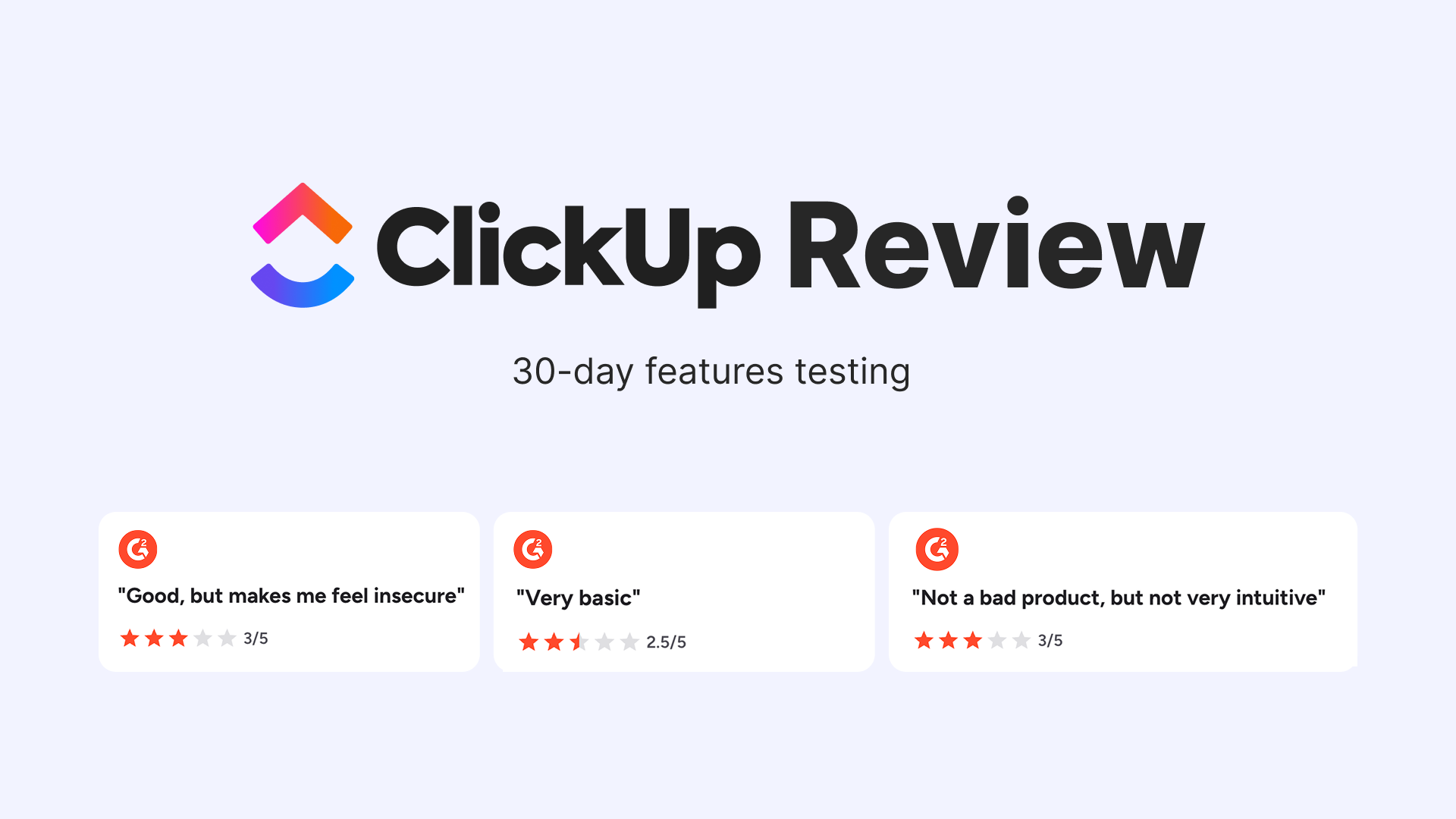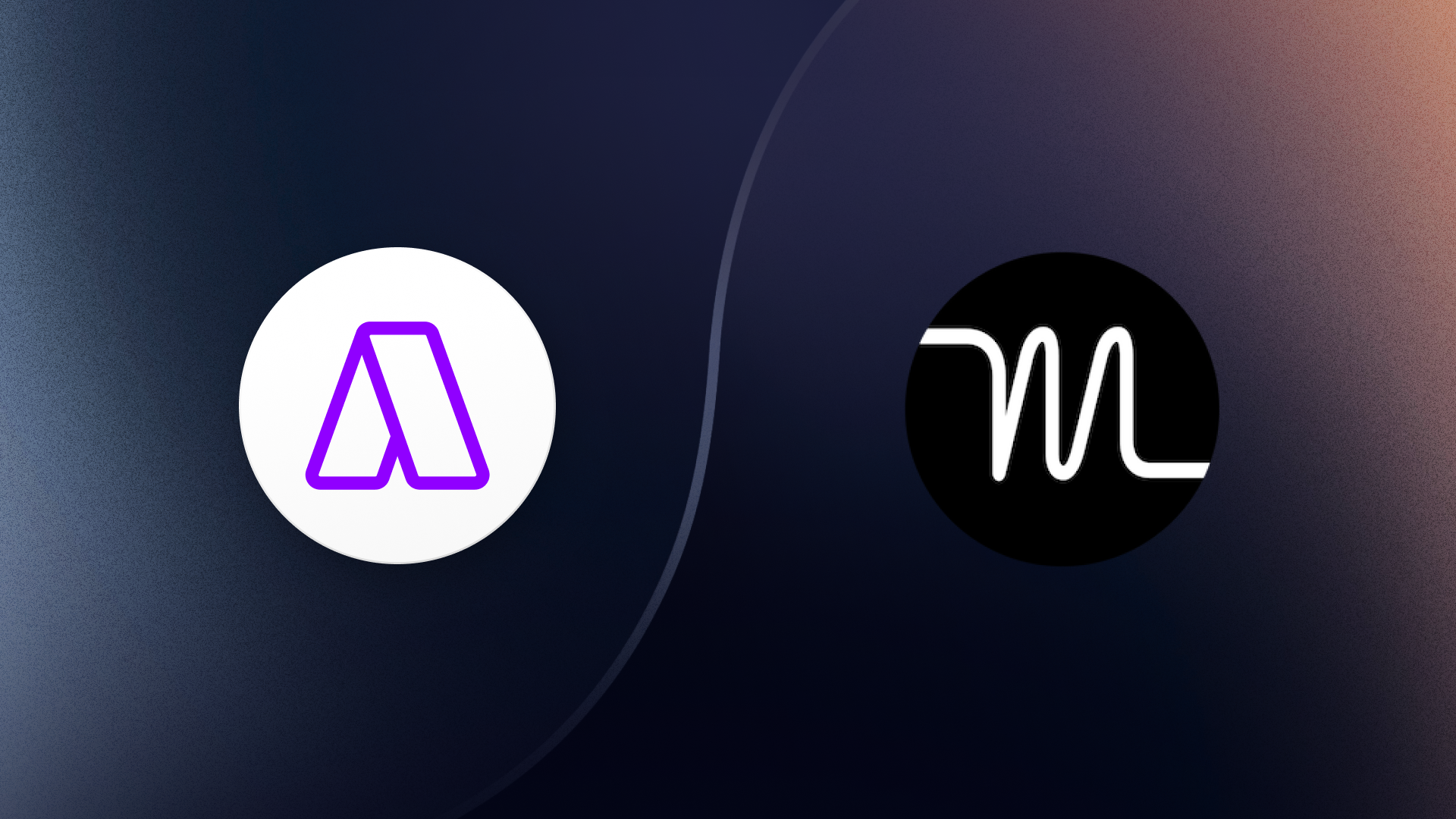10 Best Calendar Management Tools in 2025 (Features, UI, Pricing)
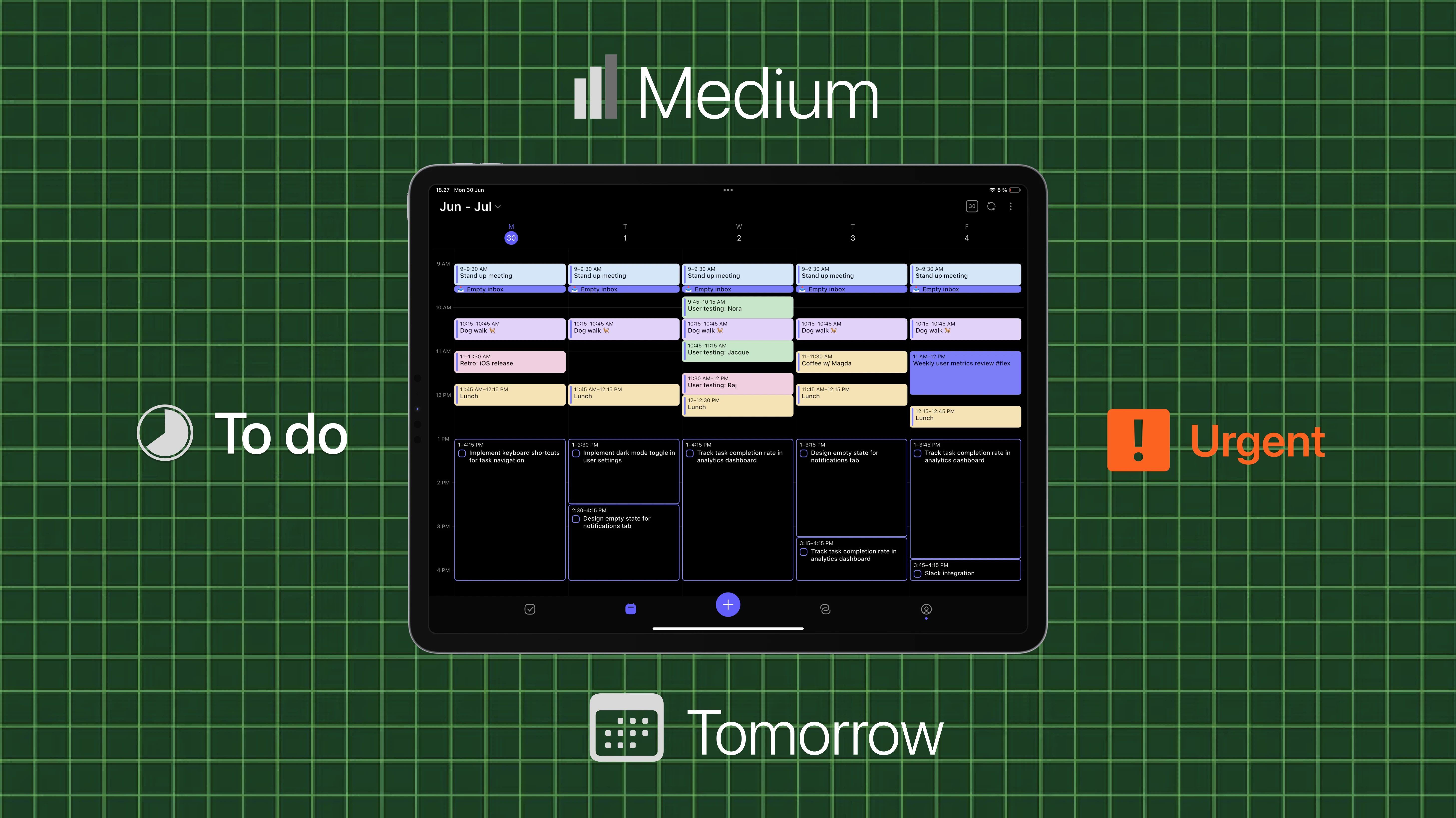
If your calendar feels less like a planning tool and more like popcorn in a hot pan, you’re not alone. Knowledge workers attend 8.3 meetings a week, compressing available time for delivering their high-quality and on-time work. The result? Time to get work done is so crunched that they struggle to meet deadlines, work overtime, or sacrifice quality.
In 2025, calendar management tools evolved from the legacy calendars you heard about (Google or Outlook calendars) into a new breed of intelligent ****systems that consolidate tasks, meetings, and priorities into one view, and in some cases, use AI to help you prioritize what to work on when.
In this guide, I’ll unpack what these tools are, why using them gives you a competitive edge at work, and how to choose the right one. Then I’ll review the 10 best calendar management apps in 2025.
What are calendar management tools?
Calendar management tools help you schedule, organize, and optimize your time, so you can stop juggling reminders and start working on what moves the needle.
Here’s how calendars have evolved:
- Yesterday’s calendars: paper diaries or basic digital apps that recorded events such as meetings and appointments with reminders.
- Today’s calendars: unified dashboards of your time that combine personal and professional calendars, tasks, and scheduling links into one system.
- Tomorrow’s calendars: AI-powered assistants that automatically block time for tasks, suggest focus periods, and reactively resolve conflicts when they appear.
This marks a shift from simply answering “Where do I need to be?” to a more sophisticated “What deserves my best energy right now?”.
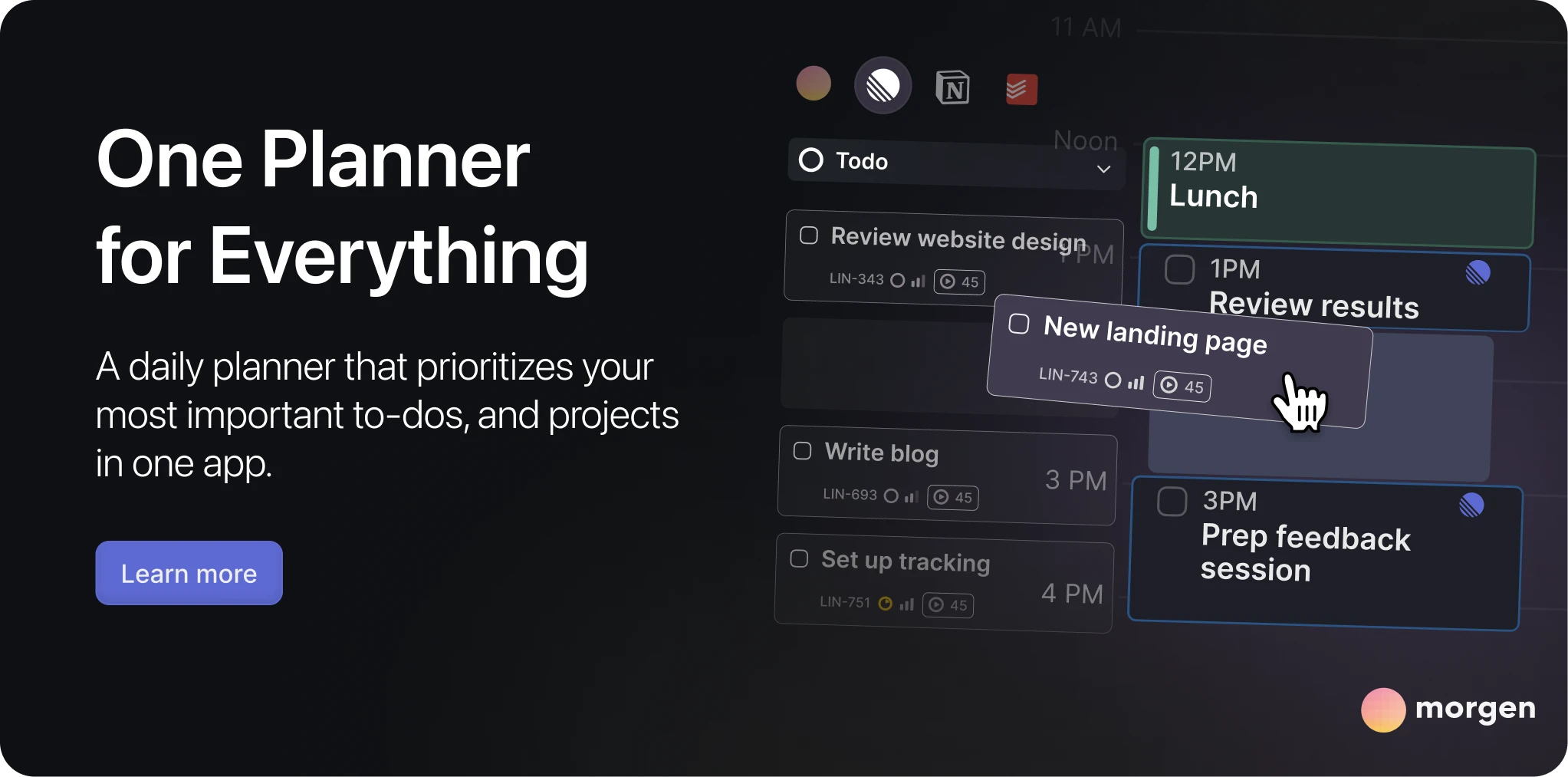
Why use calendar management apps?
The short answer is, because your brain isn’t built for constant attention (or context) switching. A smart calendar helps you plan your agenda, considering all of your commitments, and dedicate time blocks to focus on one thing at a time. A few other issues a smart calendar app helps with:
- Decision fatigue: Instead of asking “what’s next?” 20 times a day, a calendar tool helps you with your daily plan by suggesting your next priority.
- Conflicts: By having one space for personal and work calendars, these apps catch conflicts before they become problems.
- Multitasking: Spreading your attention across tasks kills focus. Time-blocking can help recover it. Research shows it boosts productivity by up to 25%.
For entrepreneurs, that means carving out strategy time amid the whirlwind of calls. For students, it’s balancing lectures, assignments, and downtime without burning out. For teams, it means transparency: teammates can see when you’ve blocked deep work hours and avoid scheduling over them.
When you use a calendar management tool well, your day stops being a reaction to last-minute requests and becomes an intentional sequence of your most important work.
Types of calendar management tools
Not all calendar apps serve the same purpose. Broadly, they fall into three categories:
- Personal calendars (Google Calendar, Apple Calendar): Great for tracking appointments, reminders, and recurring events. They’re lightweight and accessible but lack deeper planning features.
- Team calendars (Outlook, Google Calendar): Designed for visibility across colleagues, shared calendars, and room bookings. These tools excel at coordination but are not shareable across each other.
- AI-assisted planners (Morgen, Akiflow): The newest category. They merge tasks and events into one system, then use automation and AI to help you schedule tasks, protect focus time, and dynamically adjust when conflicts appear.
By knowing which category you’re in, you avoid the trap of comparing apples to oranges. A solo freelancer doesn’t need enterprise scheduling, and a large team is not as effective with a personal calendar without automations and transparency.
How to choose the best calendar management app
The “best” calendar app depends less on flashy features and more on how well it matches your workflow. Here are some criteria to consider:
- Integrations: Does it connect with the tools you already use, such as task managers, video conferencing, and project management apps?
- Cross-platform sync: Can you plan on desktop, mobile, and tablet without losing data or functionality?
- AI and automation: Does it help you schedule tasks and adjust for conflicts?
- Ease of use: Is the interface intuitive enough that you’ll use it daily?
Framework for selection:
- Solo professionals → need flexibility and task/calendar integration.
- Teams → need visibility and flexible scheduling.
- Students → need simple planning that integrates with popular task management tools to balance classes, deadlines, and personal time.
Choosing the right app is less about chasing every feature and more about finding the tool that removes friction from your specific day-to-day reality.
10 Best Calendar Management Tools in 2025
1. Morgen
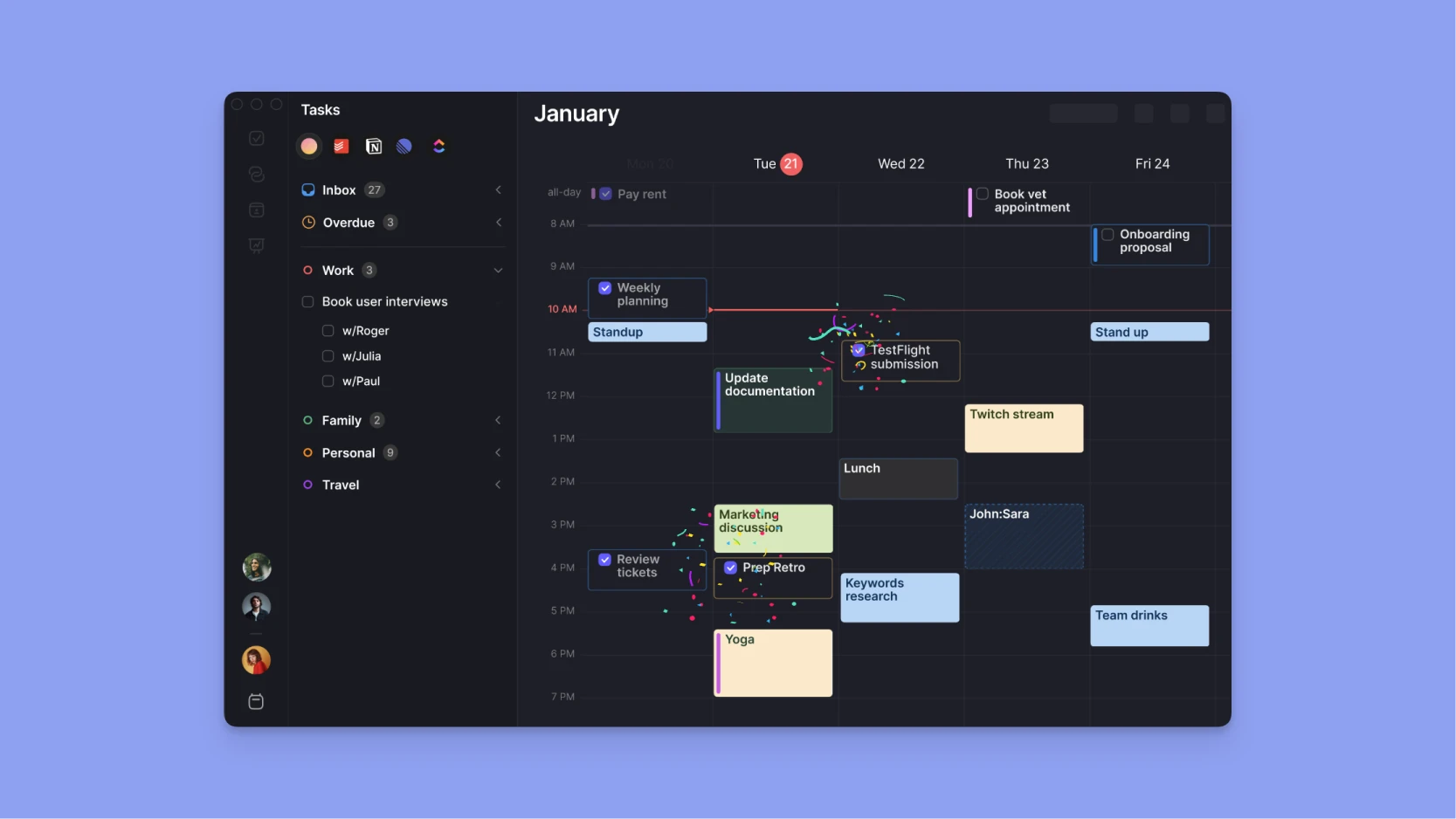
Morgen is a planning system built for people who want to be intentional with their time. Unlike traditional calendars that simply log events, Morgen consolidates all your calendars (Google, Outlook, iCloud, Fastmail) and syncs tasks from tools like Todoist, Notion, Linear, or Obsidian. The result is a single hub where you can plan your day, manually or using AI, instead of juggling disconnected apps.
Key features:
- Unified calendar view: Manage multiple calendars (Google, Outlook, iCloud, Fastmail) across accounts without double-booking yourself.
- AI Planner: Automatically designs your day based on priorities, deadlines, time estimates, and more (read about Morgen Priority Factor).
- Frames: Templates of your ideal week. Create recurring Frames to devote blocks of time to deep work, routines, or personal tasks. Then let AI schedule the appropriate tasks in the right Frames.
- Drag-and-drop time blocking: Move tasks from your sidebar directly into your calendar to protect focus time.
- Task integrations: Connect with Todoist, Notion, Microsoft To Do, and more to schedule tasks alongside meetings.
Pros:
- Provides clarity and control. You always adjust and approve the plan, ensuring you always know what to work on next
- Schedules tasks and events in one place
- Supports AI-assisted and fully manual planning styles
- Available on Windows, macOS, Linux, iOS, Android, and the web.
- Supports color-coding events to spot imbalances in your plan at a glance
- Offers custom task filters.
- Toggle views or manage events and tasks with keyboard shortcuts
Cons:
- It won’t “run itself” and schedule tasks without your approval.
Pricing: Start at $15/month for a yearly plan or $30/month with advanced features like AI Planner and Frames.
Morgen is ideal if you’re overwhelmed by scattered calendars and task apps. It doesn’t just tell you what’s scheduled, it helps you decide how to spend your time in a way that feels intentional and sustainable.
2. Google Calendar
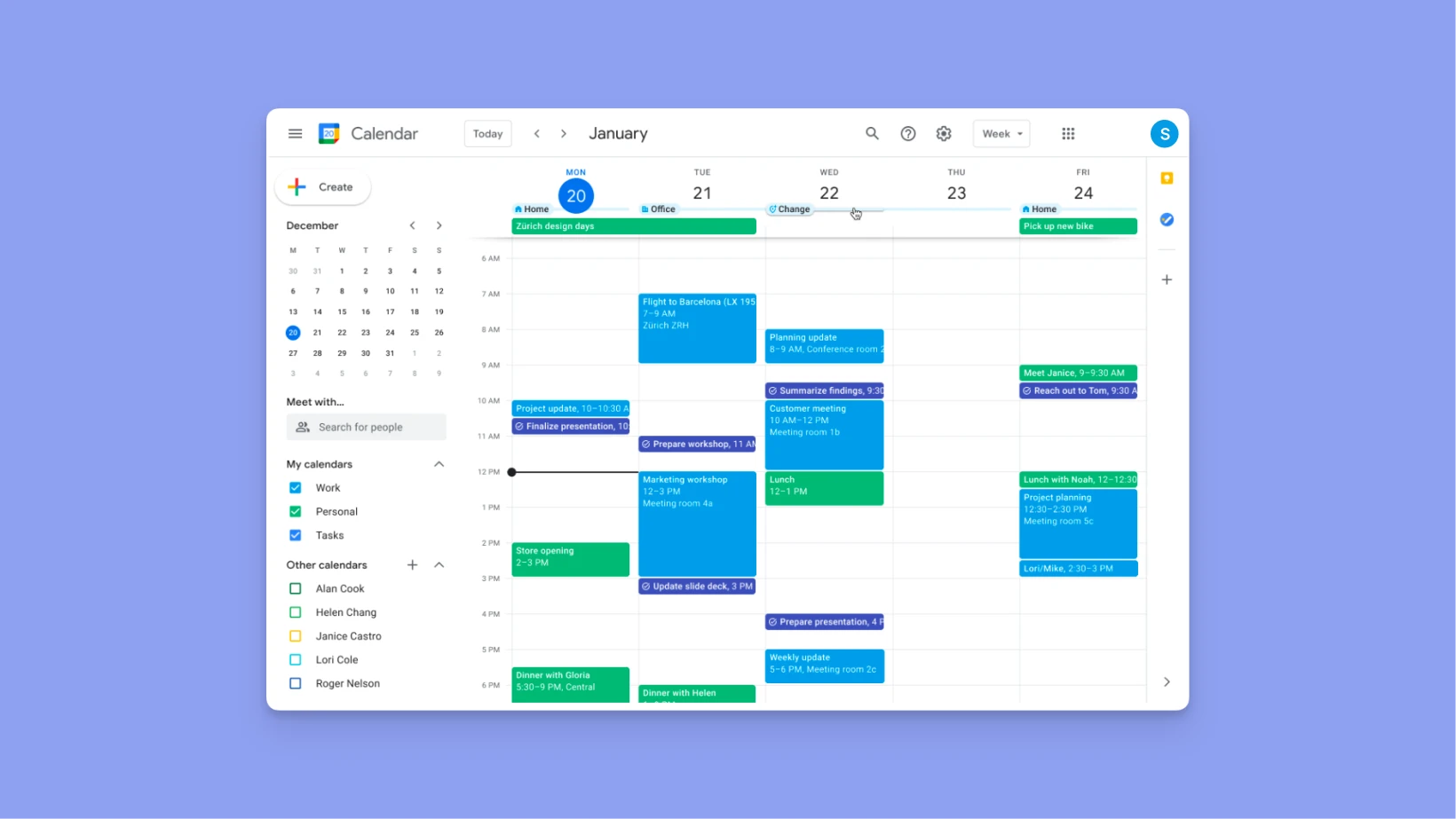
Google Calendar is the default choice for millions—and for good reason. It’s free, reliable, and integrates seamlessly with the rest of Google Workspace.
Key features:
- Simple scheduling with recurring events, reminders, and shared calendars.
- Integration with Gmail (auto-add invites) and Google Meet.
- Color-coding calendar events.
Pros:
- Free and works across almost every device
- Easy collaboration: share calendars with teammates or family in seconds
- Strong Google ecosystem support.
Cons:
- Limited task management, supporting only Google Tasks.
- Lacks integrations with other calendars or task managers.
- A few advanced planning features, such as AI or structured time-blocking.
Pricing: Free with a Google account or as part of a paid Google Workspace.
3. Outlook Calendar
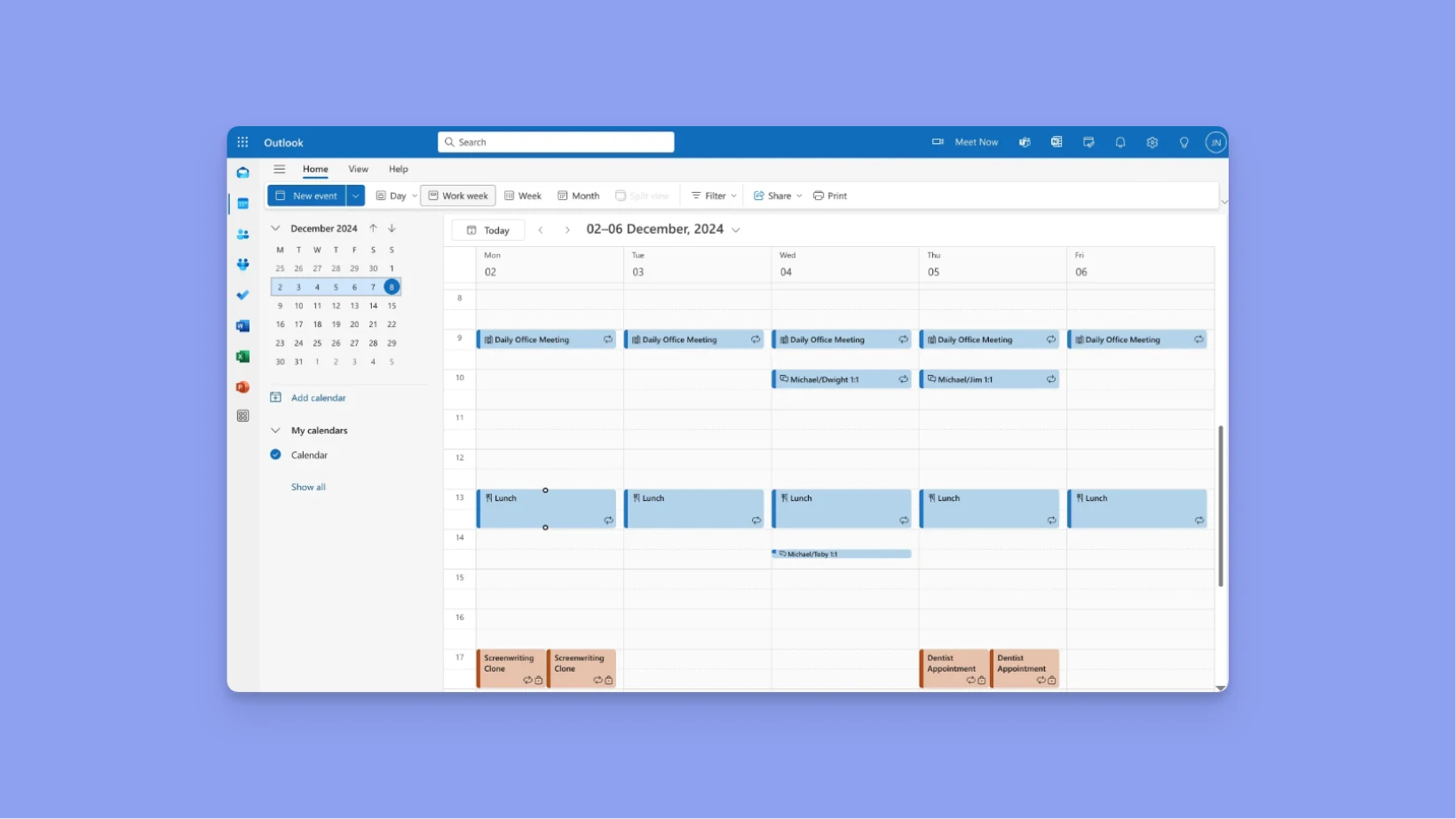
Outlook Calendar remains the backbone of corporate scheduling worldwide, thanks to Microsoft 365.
Key features:
- Main integration with Outlook email and Microsoft Teams.
- Shared team visibility.
Pros:
- Ideal for large organizations.
- Strong integration with the Microsoft ecosystem if you already use Teams and Office.
- Robust team scheduling tools.
Cons:
- Clunky interface compared to newer apps.
- Lacks integrations with other calendars or task managers.
- Overkill for individuals or small teams outside Microsoft 365.
Pricing: Included with Microsoft 365 and a free browser-only option.
4. Apple Calendar

For Apple users, Apple Calendar is the default option. It’s built into every iPhone, iPad, and Mac, and syncs across the ecosystem.
Key features:
- iCloud sync across devices, including Apple Watch.
- Integration with Siri for voice scheduling.
Pros:
- Free for anyone using Apple devices.
- Simple interface for quick scheduling.
- Part of the iOS ecosystem.
Cons:
- Lacks integrations with other calendars or task managers.
- Limited advanced features, such as AI planning.
Pricing: Free with Apple devices.

5. Fantastical
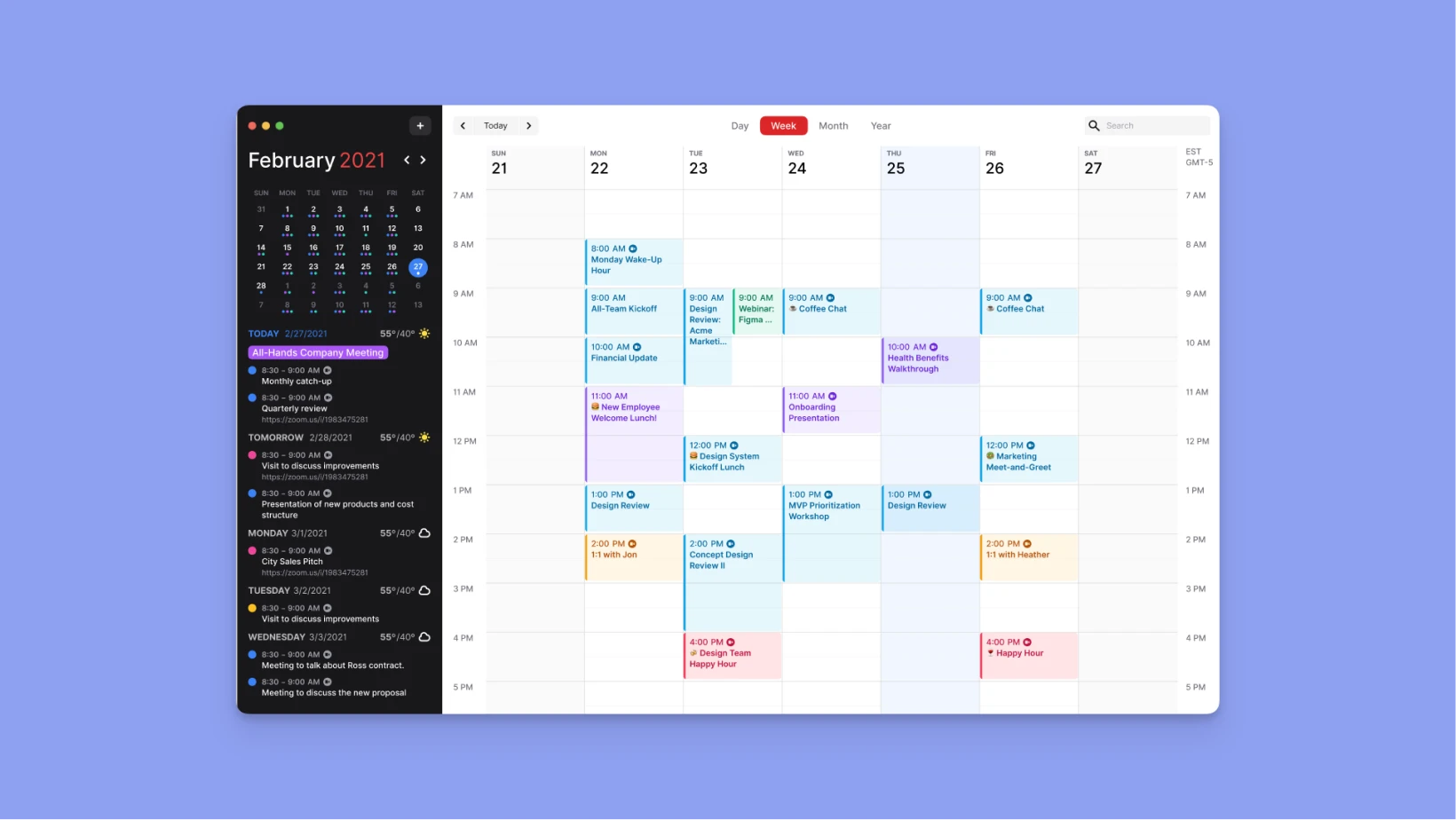
Fantastical is Apple Calendar’s stylish cousin: a premium calendar app that unifies Google, Microsoft 365, Exchange, iCloud, Todoist, and CalDAVs in one.
Key features:
- Natural language input (“Lunch with Sarah tomorrow at 1pm”) for quick event creation.
- Rich calendar views, including weather and time zones.
- Multi-account support (Google, iCloud, Outlook, etc.).
Pros:
- Well designed, clean, intuitive, and fast.
- Natural language input for easy scheduling.
- Works with Todoist
Cons:
- Subscription required for premium features.
Pricing: Free basic, Premium from $5/month.
6. Motion
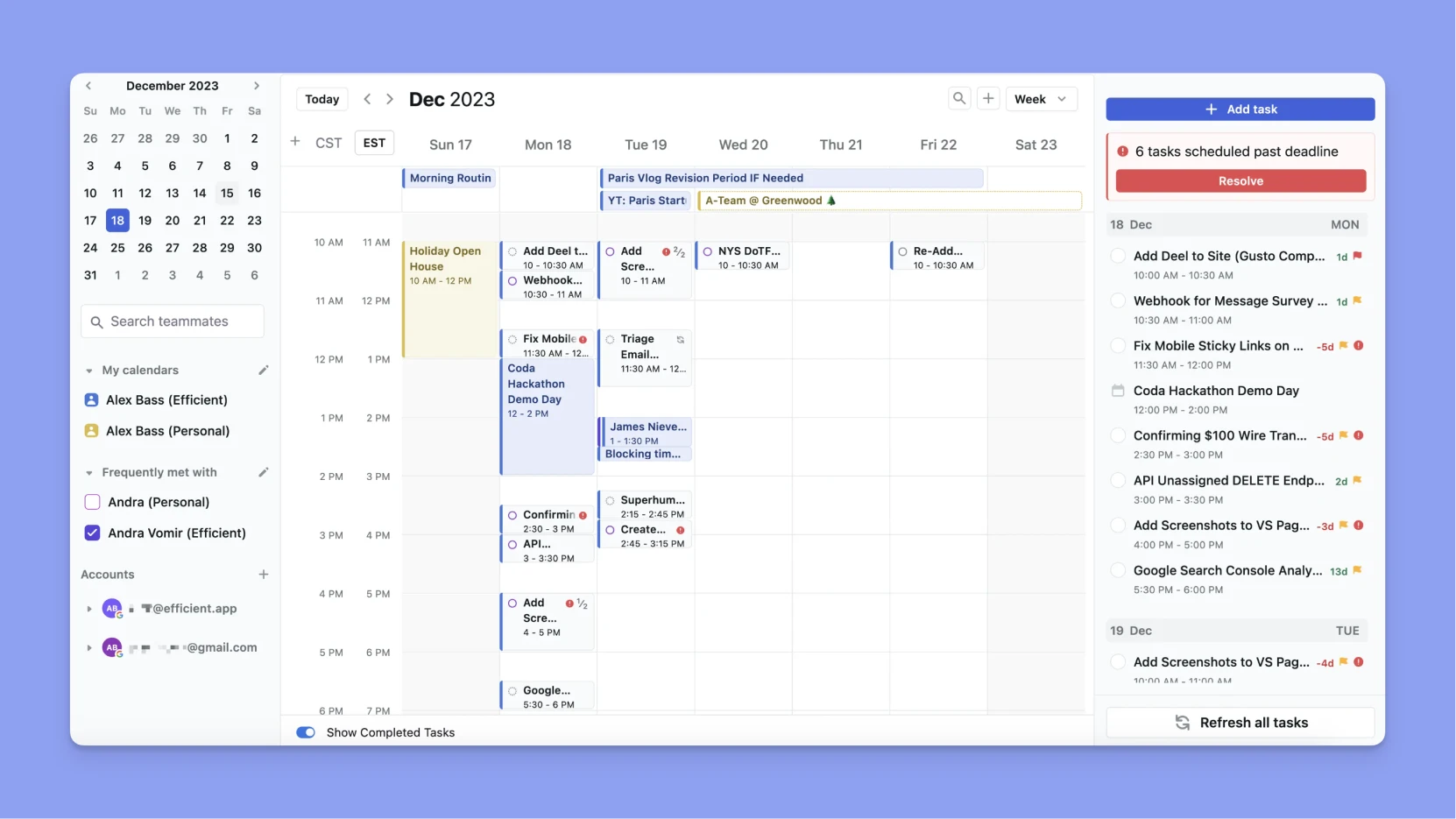
Motion takes a bold approach by having AI handle your scheduling. Instead of manually blocking tasks, you create to-dos and deadlines, and Motion automatically schedules everything for you.
Key features:
- AI scheduling for tasks and meetings.
- Auto-adjustments if meetings move.
- Automatic prioritization based on deadlines and importance.
Pros:
- Highly automated
- Maximizes calendar usage by filling idle space with tasks.
Cons:
- Less user control than other calendar apps. The AI may schedule in ways that feel unnatural.
- Steeper learning curve to make use of all features
- Higher cost than most alternatives.
Pricing: $148/month plan for 3 seats or $29/month for an individual seat.
7. Sunsama

Sunsama is the antidote to hustle-culture calendars. It focuses less on automation and optimization and more on helping you manually plan an achievable day.
Key features:
- Guided daily planning ritual.
- Integrations with Asana, Jira, Trello, and more.
Pros:
- Mindful approach to prevent burnout.
- Multiple task management integrations.
- Supports focus with its daily review ritual.
Cons:
- Less automation.
Pricing: $20/month.
8. Akiflow
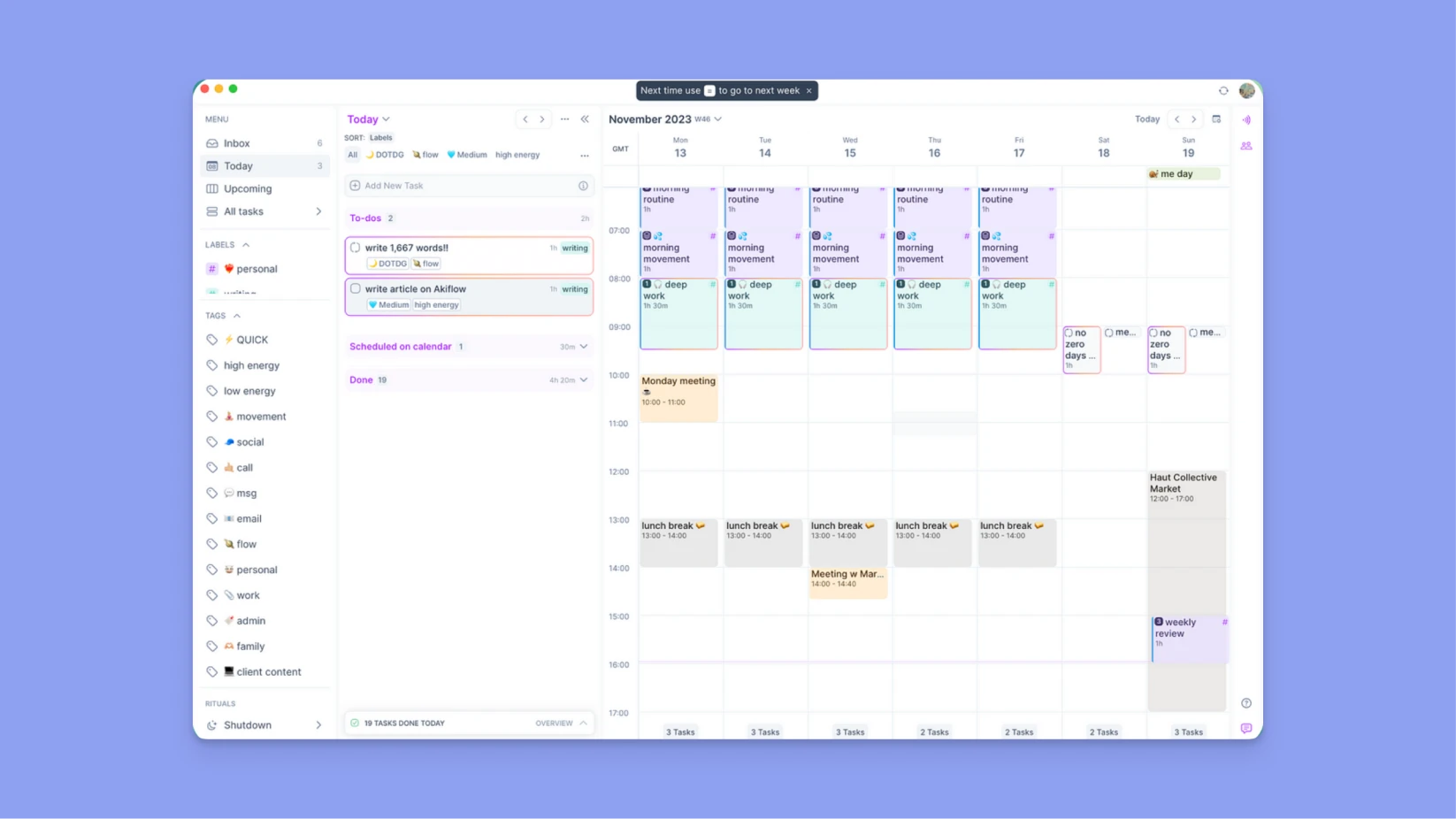
Akiflow is built for speed. It’s a keyboard-first productivity app that merges tasks and calendars into a streamlined system.
Key features:
- Universal inbox for task capture.
- Keyboard shortcuts for instant scheduling.
- Integrations with popular calendars and task apps.
Pros:
- Clean design.
- Strong task capture capabilities.
Cons:
- Tasks from integrations are sometimes out of sync
Pricing: $19/month.
9. Fastmail
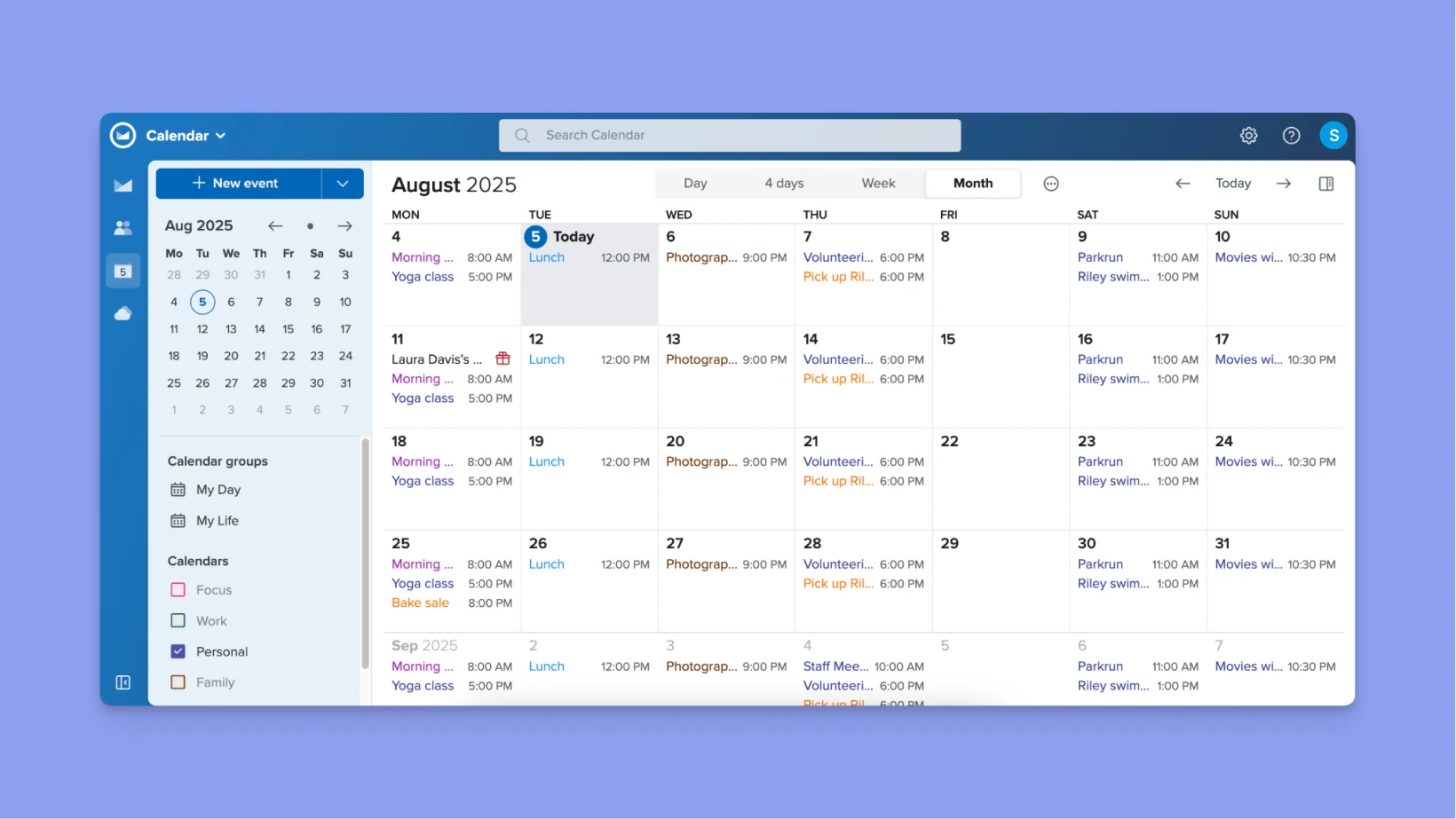
Fastmail Calendar is a fast, privacy-first calendar built into the Fastmail email service. It’s ideal if you want a clean, reliable calendar without committing to a broader office suite.
Key features:
- Fully integrated with Fastmail mail: send/receive invites, quick search, drag-and-drop.
- Share calendars publicly via read-only ICS links and subscribe to public calendars.
- Multi-user sharing with edit/view permissions inside the same account (family or business).
- CalDAV/WebCal support and sync with external services/clients (Google, iCloud, others).
Pros:
- Fast, polished web/mobile apps
- Standards-based (CalDAV/ICS), works well with Apple/Outlook and other clients.
Cons:
- Fewer deep third-party integrations than Google or Microsoft.
Pricing: Individual plan from $6/month or duo starting $10/month.
10. Notion Calendar
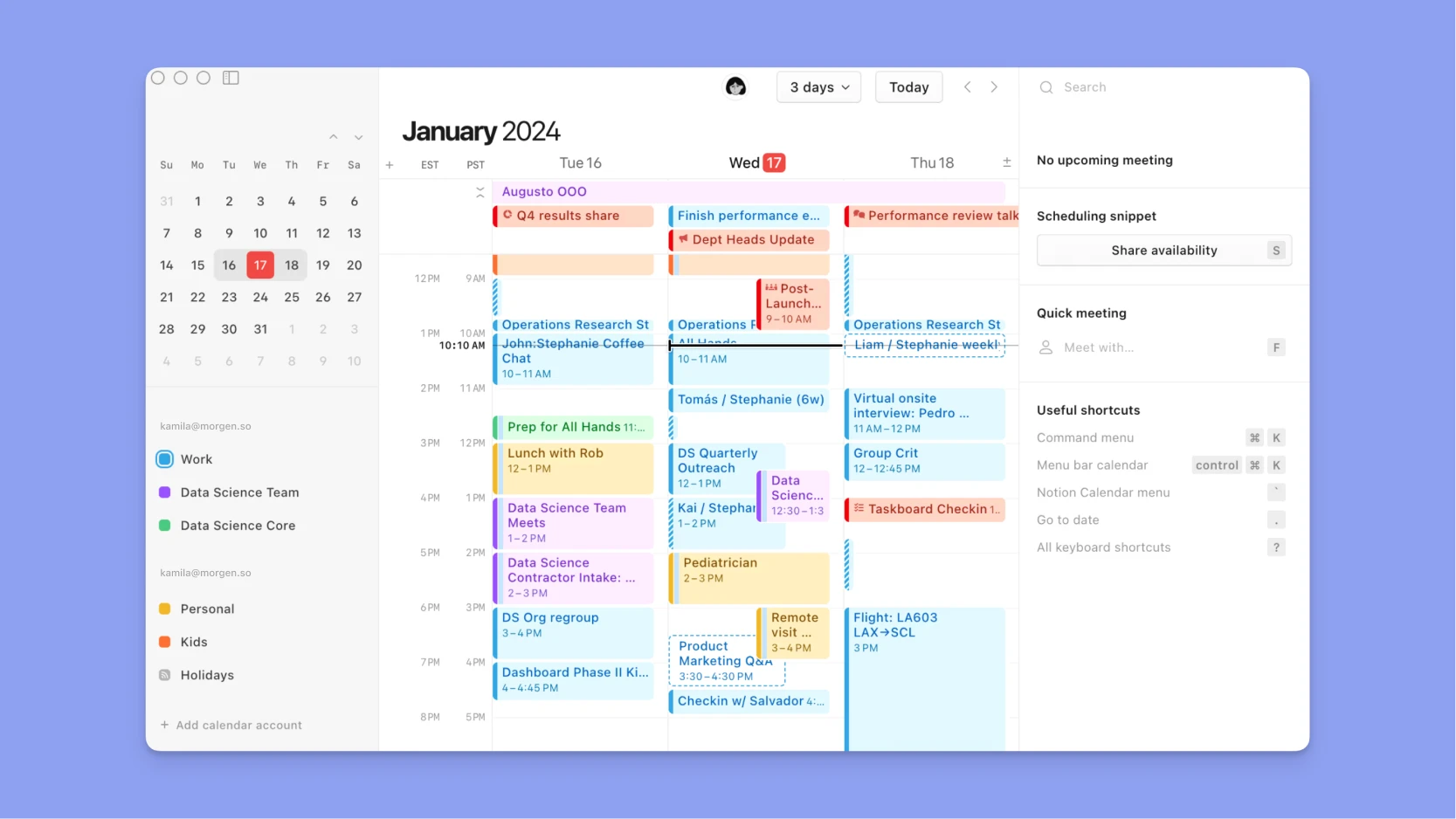
Notion Calendar is one of the newest players (previously Cron), designed to connect your calendar directly with your Notion workspace.
Key features:
- Syncs with Google Calendar.
- Direct links between Notion databases and events.
- Modern, cross-device interface.
Pros:
- Great for Notion users who want tighter integration.
- Modern design with simplicity at its core.
- Free to use.
Cons:
- Fewer features than mature tools, such as AI planning and integrations
- Best for people already invested in Notion.
Pricing: Free.
Final thoughts
Your calendar should be a system that helps you protect time for what matters most. In 2025, the best calendar management tools go far beyond simple scheduling. They consolidate your commitments, reduce decision fatigue, and even use AI to help you redesign your day when priorities shift.
If you’re looking for a tool that blends flexibility, AI assistance, and true focus on intentional work, Morgen stands out. Its combination of Frames, AI planning, and unified calendar and task view makes it one of the most forward-looking solutions for professionals who want to achieve more without burning out.
If you want a free, simple solution, Google Calendar or Apple Calendar will get the job done. If you’re part of a large organization, Outlook still dominates. And if you’re a Notion power user, Notion Calendar is worth exploring.
Ultimately, the best calendar isn’t just about what’s on your schedule. It’s about how confident you feel in the plan you’ve made.
Have questions? Send our team a message or ping me on Discord ✉️


